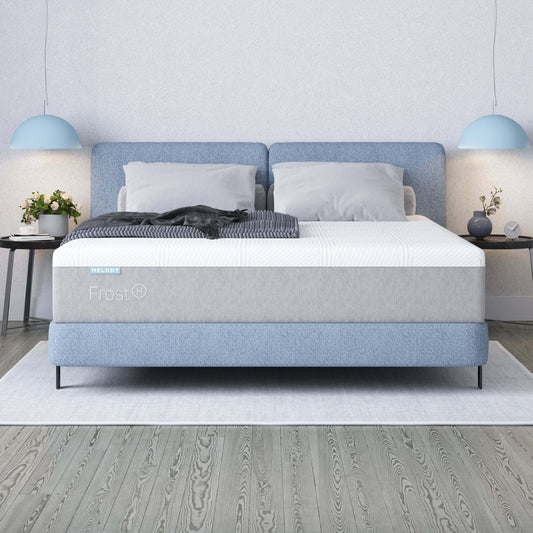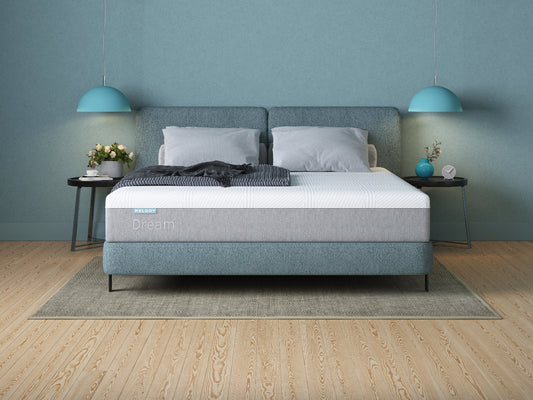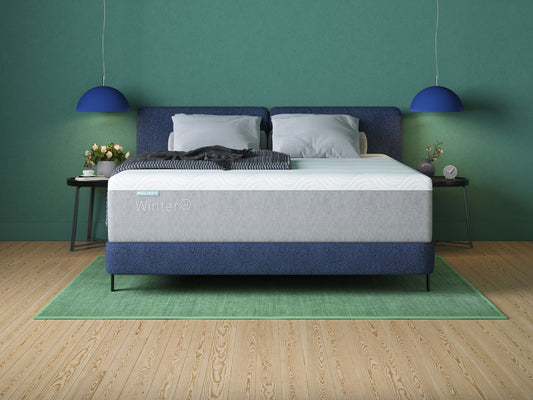Did you know that the average person spends approximately one-third of their life sleeping? With such a significant portion of our time dedicated to rest, choosing the right mattress is crucial. When it comes to memory foam vs latex mattresses, there are key differences to consider. Memory foam offers contouring support, ideal for relieving pressure points, while latex provides a more responsive and bouncy feel. Both materials have their unique benefits, from temperature regulation to durability. Understanding these distinctions can help you make an informed decision that suits your sleep preferences and needs.
What is Memory Foam
Synthetic Foam
Memory foam is a synthetic foam crafted from polyurethane, known for its viscoelastic properties. It's widely used in mattresses.
Memory foam mattresses are designed to contour and adapt to the body's shape, offering personalized comfort and support.
Body Contouring
This type of foam conforms to the sleeper's body, creating a deep hug that relieves pressure points and promotes better sleep quality.
The memory foam adjusts as you move during the night, ensuring continuous support and alignment for a restful slumber.
Firmness Variations
Across the spectrum of memory foam mattresses, there are variations in firmness levels and feel. Some are plush and soft, while others are firmer for added support.
The diverse range of firmness options caters to different preferences, ensuring individuals can find a mattress that suits their specific needs.
What is Latex Foam
Natural Latex
Latex foam is crafted from natural latex, which is derived from the sap of rubber trees. This process involves tapping the trees for their milky substance, which is then processed to create the finished latex foam.
Synthetic Latex
In contrast, synthetic latex is a man-made material produced through chemical processes. It mimics the properties of natural latex but is manufactured using different compounds.
Blended Latex
Moreover, there are latex foams that combine both natural and synthetic materials to achieve specific characteristics. These blends offer a balance between the benefits of natural and synthetic latex.
Response Time and Bounce
Latex foam stands out for its quick response time and high bounce. Unlike memory foam, which contours slowly to body movements, latex quickly adjusts to changes in pressure, providing immediate support.
Manufacturing Processes
The manufacturing process significantly impacts the density and feel of latex foam mattresses. Two common methods are Dunlop and Talalay.
- Dunlop: This process results in a denser foam at the bottom and a softer layer on top.
- Talalay: Known for its consistent cell structure, this method produces a more uniform feel throughout the mattress.
Pros and Cons of Latex Foam Mattresses
-
Pros:
- Excellent durability
- Good responsiveness and bounce
- Natural materials for eco-conscious consumers
-
Cons:
- Higher price point compared to other mattress types
- Potential for allergen sensitivity due to natural latex content
- Construction Differences
Latex vs Memory Foam
Latex Foam: Latex foam is available in both natural and synthetic forms. The natural latex is derived from rubber tree sap, providing a sustainable and eco-friendly option. On the other hand, synthetic latex is made from petrochemicals, offering a more affordable alternative.
Memory Foam: Memory foam is entirely synthetic, created using polyurethane and other chemicals. It contours to the body's shape, providing excellent pressure relief and support. Some memory foams also incorporate cooling materials like gel or copper to address heat retention issues.
Manufacturing Impact
Latex Foam: The manufacturing process significantly affects the feel and durability of latex foam mattresses. The Dunlop method results in a denser bottom layer, ideal for support, while the Talalay process produces a softer feel with consistent firmness throughout.
Memory Foam: In contrast, memory foam mattresses are known for their ability to mold to the body's shape, offering personalized comfort and support. However, they can retain heat due to their dense composition, leading to potential discomfort for some sleepers.
Material Composition
Latex Foam: Latex foam consists of latex material sourced from either natural rubber trees or synthetic sources. Its blend of materials provides a responsive and supportive surface that contours to the body without sinking excessively.
Memory Foam: Memory foam primarily comprises polyurethane foam, known for its ability to conform to body curves and relieve pressure points. Manufacturers often infuse memory foam with additional materials like gel or copper to enhance cooling properties and improve overall sleep quality.
Feel and Comfort Comparison
Pronounced Hug vs Generalized Compression
Memory foam provides a pronounced hug, conforming closely to the body's curves, offering a feeling of being cradled. In contrast, latex foam offers a more generalized compression, providing support without the same level of contouring.
Lighter Feel and Bounce
Latex foam is known for its lighter feel and bounciness, allowing for easy movement during sleep. On the other hand, memory foam has a denser feel, which some individuals prefer for its cocooning effect.
Varying Comfort Levels
Individuals seeking a mattress with a deeper sink may prefer memory foam, as it tends to allow for more sinkage due to its slow response time. Conversely, latex foam provides a quicker response time, catering to those who prefer less sinkage and more support.
Firmness Options
Memory Foam
Memory foam mattresses offer a wide range of firmness options, catering to various preferences. The firmness levels can range from soft to extra firm, providing choices for different sleepers. This variability in firmness makes memory foam a versatile option for those seeking customized comfort.
One of the key factors influencing the firmness of memory foam mattresses is their density. Higher density foams tend to be firmer, while lower density foams are softer. The thickness of the memory foam layer also plays a role in determining the overall firmness of the mattress. Thicker layers often result in a plusher feel, offering more sinkage and contouring to the body.
Latex Foam
In contrast to memory foam, latex mattresses typically offer a more consistent level of firmness across their varieties. Whether you choose natural or synthetic latex, you can expect a reliable and uniform feel throughout the mattress. Latex foam's inherent bounciness and responsiveness contribute to its consistent firmness, providing a supportive yet comfortable sleep surface.
When deciding on the firmness level for your mattress, it's essential to consider your personal preference and body weight. Lighter individuals may prefer softer mattresses to allow for better contouring, while heavier individuals might opt for firmer mattresses for enhanced support. Understanding how your weight and sleeping habits influence your comfort preferences can help you select the ideal firmness level for both memory foam and latex mattresses.
Factors Influencing Choice
The choice between memory foam and latex mattresses ultimately comes down to individual preferences and needs. While memory foam offers a broader range of firmness options, latex provides a more consistent feel. Consider factors such as your preferred sleeping position, any existing back or joint pain, and whether you tend to sleep hot or cool when selecting the right firmness level for your mattress.
- Memory foam: Offers a wide range of firmness options
- Latex foam: Provides consistent firmness across varieties
Support for Joint Pain
Contouring Properties
Memory foam's contouring properties are well-known for their ability to alleviate pressure points and provide excellent support for joint pain. The material conforms to the body, distributing weight evenly and reducing stress on joints. This feature helps in maintaining proper spinal alignment, crucial for alleviating back pain and other joint issues.
Minimal Sinkage
Latex foam, on the other hand, offers support without excessive sinkage, making it an ideal choice for individuals with joint problems. This material provides a more responsive feel compared to memory foam, ensuring that users do not feel stuck in the mattress. The compression of latex foam is minimal, allowing for easy movement during sleep without compromising on support.
User Experiences
User experiences play a significant role in determining the preferred material for joint pain relief. Many individuals suffering from joint issues find that memory foam mattresses offer the right balance of pressure relief and support. The contouring nature of memory foam helps in reducing discomfort and promoting better sleep quality.
-
Memory foam:
- Excellent pressure relief
- Conforms to the body shape
-
Latex foam:
- Responsive feel
- Minimal sinkage
- Sleeping Position Suitability
Side Sleepers
Side sleepers often benefit from memory foam mattresses due to their exceptional contouring ability. This feature allows the mattress to conform closely to the curves of the body, providing targeted support for the shoulders and hips. The pressure relief offered by memory foam can help alleviate discomfort in these areas, promoting a more comfortable sleep for side sleepers.
Back and Stomach Sleepers
For back and stomach sleepers, latex foam mattresses are often recommended. Latex foam is known for its responsiveness, offering a more buoyant feel compared to memory foam. This responsiveness helps maintain proper spinal alignment for back and stomach sleepers, reducing the risk of waking up with aches and pains. Latex foam provides a firmer surface that prevents excessive sinking, which can be beneficial for these sleeper types.
Personal Comfort and Sleeping Habits
When choosing between a memory foam and latex mattress, it's essential to consider personal comfort preferences and sleeping habits. While general guidelines exist regarding which type of mattress may be better suited for specific sleeper types, individual comfort plays a significant role in determining the most suitable option. Factors such as preferred firmness level, temperature regulation, and overall feel should also be taken into account when selecting a mattress.
Trial Periods and Warranties
Importance
Manufacturers offer trial periods for both memory foam and latex mattresses, allowing customers to test the product at home. This is crucial as it can take time for the body to adjust to a new mattress, ensuring customers are satisfied with their purchase.
Comparison
Warranty lengths vary significantly between memory foam and latex mattresses. Memory foam mattresses typically come with warranties ranging from 10 to 25 years, while latex mattresses often have warranties lasting 20 years or more. Consumers should consider this difference when making a purchase decision.
Fine Print
It is essential for consumers to read the fine print regarding return policies and warranty coverage. Some manufacturers may offer trial periods but have strict return policies, while others provide generous warranties but with specific conditions. Understanding these details can help customers make informed decisions.
Shipping Methods
Ways
Memory foam mattresses are commonly shipped using compression methods, where the mattress is rolled and compressed into a box for delivery. This allows for easier handling and transportation, reducing the risk of damage during shipping. On the other hand, latex mattresses may be shipped differently due to their weight and construction.
Manufacturing Processes
The manufacturing processes of memory foam mattresses often involve compressing the foam layers before packaging. This compression allows the mattress to be easily rolled up and shipped in a compact box. Latex mattresses, known for their durability and resilience, may have a different manufacturing process that requires special care during shipping to maintain their quality.
Sinkage
One consideration when it comes to shipping methods is the potential sinkage of the mattress. Memory foam mattresses, especially those that have been compressed for shipping, may need time to fully expand and regain their original shape once unpacked. Latex mattresses, being more resilient, may not experience as much sinkage during shipping but could still require time to settle into their optimal firmness level.
Use
When purchasing a mattress online, it's crucial to consider the shipping costs and delivery times associated with each type. Memory foam mattresses, due to their compression for shipping, may offer more affordable shipping rates compared to latex mattresses. However, latex mattresses may require specialized shipping methods due to their weight and bulk, potentially leading to higher shipping costs.
Pros and Cons of Each
Memory Foam
Excellent Contouring: Memory foam molds to the body, providing excellent contouring for personalized comfort and support. This feature ensures a good night's sleep by relieving pressure points.
Pressure Relief: One of the benefits of memory foam is its ability to distribute weight evenly, thereby reducing pressure on joints and muscles. This results in a more restful and pain-free sleep experience.
Drawbacks:
- Heat Retention: A common issue with memory foam is its tendency to retain heat, potentially causing discomfort during warmer nights.
- Durability Concerns: Over years, memory foam mattresses may lose their shape and supportive properties, impacting their longevity.
Latex Foam
Better Cooling Properties: Latex foam is known for its natural breathability, allowing for better air circulation and temperature regulation. This feature makes it an excellent choice for hot sleepers or those living in warmer climates.
Responsiveness: Latex foam offers quick responsiveness, meaning it adjusts to your movements almost instantly. This quality ensures that you won't feel stuck in the mattress and can easily change positions during the night.
Drawbacks:
- Potential Cost Differences: Latex mattresses tend to be more expensive than memory foam counterparts due to the market prices of latex material. This cost disparity may deter budget-conscious buyers.
- Weight: Latex mattresses are generally heavier than other types, making them challenging to move or rotate over time.
Closing Thoughts
You've explored the differences between memory foam and latex mattresses, considering construction, feel, firmness, support, sleeping positions, trials, and warranties. Both offer unique benefits, with memory foam excelling in contouring comfort and pressure relief while latex provides a bouncier, more natural option with durability. Your choice should align with your preferences for feel, support needs, and any specific health considerations. Now armed with this knowledge, you can make an informed decision based on what matters most to you. Remember to test out mattresses in person if possible and take advantage of trial periods to ensure the perfect fit for your sleep needs.
Frequently Asked Questions
What are the key differences between memory foam and latex mattresses?
Memory foam mattresses contour to your body shape, providing pressure relief and motion isolation. Latex mattresses offer a responsive and bouncy feel with natural cooling properties. Memory foam tends to retain more heat, while latex is more durable in the long run.
Which type of mattress is better for joint pain relief: memory foam or latex?
Both memory foam and latex mattresses can alleviate joint pain due to their ability to conform to the body's contours and provide support. Memory foam excels in pressure relief, especially for side sleepers, while latex offers a more buoyant support suitable for back and stomach sleepers.
Do memory foam mattresses have a strong chemical odor?
Memory foam mattresses may have a slight chemical smell known as off-gassing when first unpacked. This odor typically dissipates within a few days to a couple of weeks, depending on the mattress quality and ventilation in the room.
Are memory foam or latex mattresses suitable for all sleeping positions?
Memory foam mattresses are versatile and cater to various sleeping positions, offering excellent pressure relief for side sleepers and adequate support for back and stomach sleepers. Latex mattresses are also suitable for all sleeping positions but provide more bounce and responsiveness compared to memory foam.
How do trial periods and warranties differ between memory foam and latex mattresses?
Most memory foam and latex mattress brands offer trial periods ranging from 90 to 120 nights, allowing you to test the mattress at home. Warranties typically cover manufacturing defects like sagging or indentations; memory foam mattresses usually have longer warranty periods than latex mattresses.




